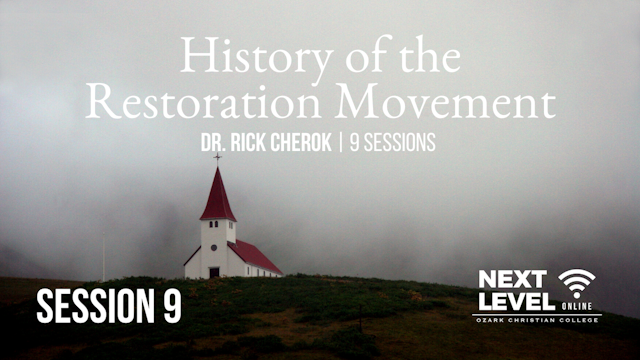Overview of the Movement Today


The vision of Ozark Christian College is to glorify God by evangelizing the lost and edifying Christians worldwide. The mission of Ozark Christian College is to train men and women for Christian service as a degree-granting institution of biblical higher education.
Quick Review:
Primary Objectives of the Restoration Movement:
Unity
Truth
Win the World to Christ (the most important objective!)
Leading Figures in the Movement’s Early Development:
Barton W. Stone – Kentucky Christians and The Last Will and Testament of the Springfield Presbytery
Thomas Campbell – The Declaration and Address of the Christian Association of Washington
Alexander Campbell – Disciples of Christ
Walter Scott – Evangelist
Divisions of the Restoration Movement:
Christian Church (Disciples of Christ)
1968 – Through the process of “Restructure,” the Disciples organized themselves into a Mainline Denomination with a headquarters in Indianapolis, and General Minister and President, and a denominational logo.
Theologically Liberal and more concerned about social issues than evangelism.
Attendance numbers among the Disciples has seen a dramatic decline in the past several years.
Churches of Christ (Non-Instrumental)
Christ turned inward as a somewhat Fundamentalist group.
- Two primary groups among the a capella churches:
- Non-Instrumental Churches (Mainline Churches of Christ) – Maintain their a
capella tradition, but as their preferred form of worship.
- Anti-Instrumental Churches (Non-Institutional Churches of Christ) – View the
use of musical instruments as a salvation issue (it is absolutely wrong!).
- Conservative, Biblically oriented, and very concerned about evangelism.
Christian Churches/Churches of Christ – Also known as Independents
Convention, but only as a conservative element among the Disciples of Christ.
- Between 1927 and 1971, a chasm developed between the conservatives and
liberals within the Disciples of Christ.
- **1971** – Officially listed separately from the Disciples of Christ in the Yearbook of American Churches.
- Conservative, Biblically oriented, and very concerned about world evangelism.
- CC/CC has proven to be a very evangelistic group with impressive growth over
the past years: Many mega-churches and a large number of missionaries
Additional Resources:
Foster, Douglas A., Paul M. Blowers, Anthony L. Dunnavant, and D. Newell Williams, eds. – The Encyclopedia of the Stone-Campbell Movement
Garrett, Leroy – *The Stone-Campbell Movement: The Story of the American
Restoration Movement*
Murch, James DeForest – Christians Only: A History of the Restoration Movement
North, James B. – Union in Truth: An Interpretive History of the Restoration Movement
Webb, Henry E. – In Search of Christian Unity: A History of the Restoration Movement
Williams, D. Newell, Douglas A. Foster, and Paul M. Blowers – The Stone-Campbell Movement: A Global History
Quick Review:
Primary Objectives of the Restoration Movement:
Unity
Truth
Win the World to Christ (the most important objective!)
Leading Figures in the Movement’s Early Development:
Barton W. Stone – Kentucky Christians and The Last Will and Testament of the Springfield Presbytery
Thomas Campbell – The Declaration and Address of the Christian Association of Washington
Alexander Campbell – Disciples of Christ
Walter Scott – Evangelist
Divisions of the Restoration Movement:
Christian Church (Disciples of Christ)
1968 – Through the process of “Restructure,” the Disciples organized themselves into a Mainline Denomination with a headquarters in Indianapolis, and General Minister and President, and a denominational logo.
Theologically Liberal and more concerned about social issues than evangelism.
Attendance numbers among the Disciples has seen a dramatic decline in the past several years.
Churches of Christ (Non-Instrumental)
Christ turned inward as a somewhat Fundamentalist group.
- Two primary groups among the a capella churches:
- Non-Instrumental Churches (Mainline Churches of Christ) – Maintain their a
capella tradition, but as their preferred form of worship.
- Anti-Instrumental Churches (Non-Institutional Churches of Christ) – View the
use of musical instruments as a salvation issue (it is absolutely wrong!).
- Conservative, Biblically oriented, and very concerned about evangelism.
Christian Churches/Churches of Christ – Also known as Independents
Convention, but only as a conservative element among the Disciples of Christ.
- Between 1927 and 1971, a chasm developed between the conservatives and
liberals within the Disciples of Christ.
- **1971** – Officially listed separately from the Disciples of Christ in the Yearbook of American Churches.
- Conservative, Biblically oriented, and very concerned about world evangelism.
- CC/CC has proven to be a very evangelistic group with impressive growth over
the past years: Many mega-churches and a large number of missionaries
Additional Resources:
Foster, Douglas A., Paul M. Blowers, Anthony L. Dunnavant, and D. Newell Williams, eds. – The Encyclopedia of the Stone-Campbell Movement
Garrett, Leroy – *The Stone-Campbell Movement: The Story of the American
Restoration Movement*
Murch, James DeForest – Christians Only: A History of the Restoration Movement
North, James B. – Union in Truth: An Interpretive History of the Restoration Movement
Webb, Henry E. – In Search of Christian Unity: A History of the Restoration Movement
Williams, D. Newell, Douglas A. Foster, and Paul M. Blowers – The Stone-Campbell Movement: A Global History
© Live Church Solutions. All rights reserved.
